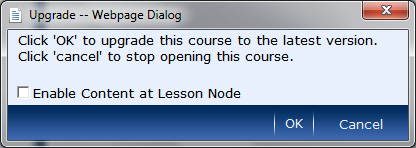- E-learning created is compatible with Firefox 3.5.9 and Firefox 3.6.3.
- Microsoft Silverlight 4 Media Player for animations that include closed captioning.
- Enhanced keyboard accessibility for the sort and tile games, adventure interactivity, and Voice of the Expert element.
- LCDS authoring and e-learning created are completely compatible with Microsoft Silverlight 4.0.
Tag: Learning
Why did Yanina not fill in her whereabouts?
I was watching the interview of tennis player Yanina Wickmayer where she explains why she did not fill in her whereabouts in the ADAMS computer system. As a result, she got suspended for one year.
I do not want to take any position about this decision (there are enough Facebook groups that do that), but this story reveals some typical problems that need to be addressed when introducing a new software tool:
- Communicate clearly: the “business rules” need to be communicated clearly, so that the user knows the policy and guidelines. For that, you use the proper way of communication with your users (oral, e-mail, …) Sending letters to the home address of a globetrotter does not fall under “proper way of communication”.
- Motivate: if your users know the philosophy of your application, why it makes things easier and what the benefits are, chances are much higher that the tool will be accepted.
- Make it look nice:while applications are judged by IT people on their functionalities, the end users have a lot of interest for the “look & feel” of the application. If it looks good, your application will “sell better”.
- Leverage technology: a web application is a good choice for a global, world wide application, but “a pc connection to the internet” does not seem to be always available to the sporters. But I’m sure they all have a Blackberry. Why not make a mobile app?
- Train and document: the ADAMS application is a great example where the use of e-learning would be very appropriate: lot’s of users, spread over the entire world. Short demos, faqs, procedures…
WADA, Vlaamse Overheid, if you need any help, let me know. I see it as my contribution to Belgian top tennis.
My Top Learning Tools
Jane Hart keeps a list of Top Learning Tools, submitted by learning professionals from all over the world. This is my top list:
1. SharePoint: has become my platform of choice for knowledge sharing. The My Site stores all my content, shared or not shared, and makes it accessible from anywhere.
2. OneNote: because of its integration with other Microsoft Office products, I prefer OneNote over other note taking tools like Evernote.
3. Captivate: has been my favorite screencasting tool since version 1.0, because of its ease of use and flexible outputs.
4. Camtasia: my alternative for Captivate when it comes to recording complex applications that need real-time recording.
5. Jing: an ideal screencast recorder for “quickies”
6. WordPress: a versatile weblog with a great community around it
7. Delicious: has replaced my favorites and is quickly becoming my personal web memory
8. Google Reader: allows you to follow hundreds of RSS feeds, share posts, rate them…
9. TweetDeck: Twitter is great if you want to follow the “buzz” of the moment, but it would be impossible to manage the stream without an application like TweetDeck.
10. Adobe Presenter: one of the easiest PowerPoint converters with video, quizzing and SCORM support.
User adoption has not changed since the Middle Ages
A lot of IT projects fail because users struggle with the change that the new tools bring them. As an IT implementer or trainer, it is good to “unlearn” everything you know about the software, and view it from a user perspective.
The video below shows that what is simple, is not always obvious!
SharePoint in Plain English
The people from CommonCraft have created a new video about SharePoint. If you want to learn what it is and what it can do for you in 3 minutes, this is the way to go:


